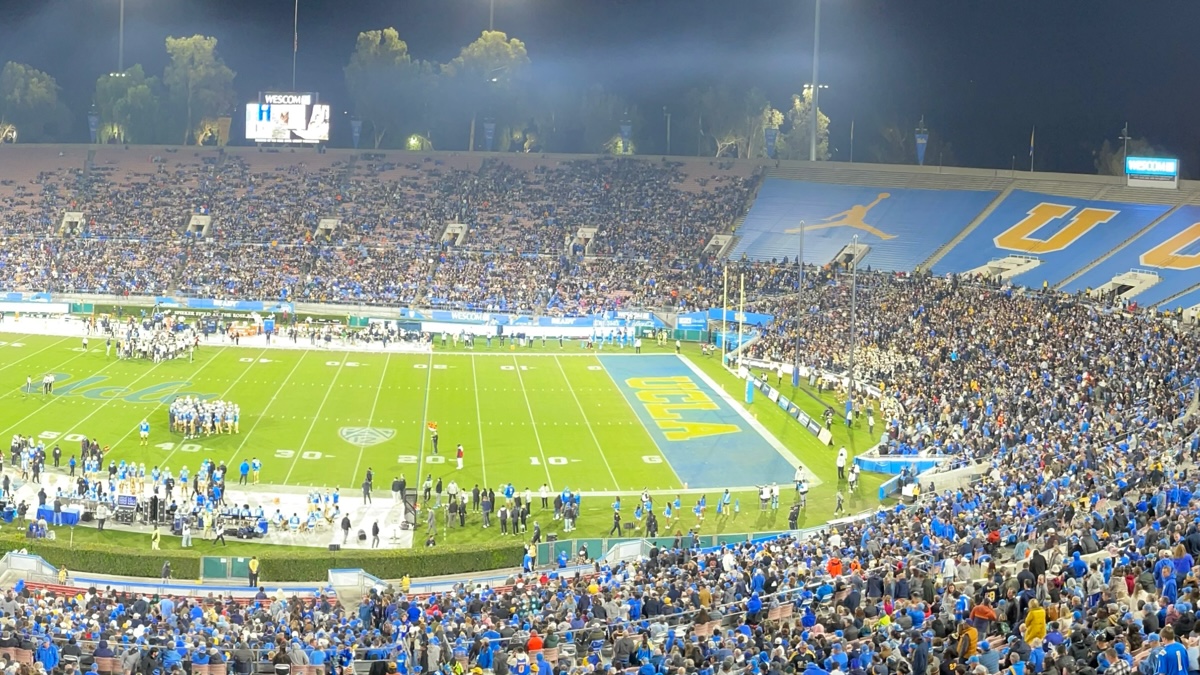
Two historic West Coast institutions intersected one last time on November 25, one looking ahead to a bright future and the other digesting a sudden demise.
The Pac-12 Conference’s roots date to 1915 when charter members California, Oregon, Oregon State and Washington started the Pacific Coast Conference. Washington State joined in 1917, Stanford in 1918, USC in 1922 and UCLA arrived in 1928. Arizona and Arizona State joined the Pac-8 in 1978, making it the Pac-10; Colorado and Utah joined in 2011, making it the Pac-12.
The Rose Bowl Stadium opened in 1922 and has hosted games in the conference every year since — until next year, when the conference will implode as 10 members leave for other conferences, leaving only Oregon State and Washington State.
Sponsored Content
The Rose Bowl Stadium has been around for 101 years and is steeped in tradition that encompasses dozens of college football programs. It was designated a National Historic Landmark in 1987 by the National Park Service. Some of the greatest moments in the sport — or any sport — have taken place on the perfectly manicured turf of the nearly 100,000-seat cathedral in Pasadena, California.
While it’s fun to take a stroll down memory lane when walking through the California High School Football Hall of Fame or the 1922 Locker Room, the famous venue is also plowing forward into its second century, taking the opposite path of the Pac-12. The stadium underwent renovations from 2011 through 2014, the main project being the addition of the Terry Donahue Pavilion — a premium hospitality and seating area. The stadium also has seen many other upgrades, including the new LED lights that were on display when UCLA took on California on November 25 for the last time the Pac-12 as we know it would play a regular-season matchup.
The Rose Bowl Legacy Foundation
They say you have to spend money to make money and that’s a true statement with the Rose Bowl. It isn’t cheap to keep the stadium at the level that fans have become accustomed to, which is where the Rose Bowl Legacy Foundation comes into play.
“It’s like a house. If you leave a house vacant, a lot of stuff starts falling apart because you don’t have eyes on it,” said Jens Weiden, chief executive officer of the Rose Bowl Operating Company. “But the real big piece of that is staying busy. And that’s really what we’ve tried to do. We’re busy with UCLA football and the Rose Bowl game and concerts. Those events not only keep eyes — and people that have really high standards — on the stadium, but it also makes money.”
The Legacy Foundation is a 501(c)3 nonprofit that works to maintain and enhance the Rose Bowl by providing private funding in support of improvements within the venue and its surrounding areas through educational, community and capital improvements. Since its inception in 2010, the foundation has raised $54 million put directly into the stadium.
“It was originally founded by our former, now-retired CEO Darryl Dunn and funded by 23 local donors of Pasadena in 2010,” said Dedan Brozino, president of the Legacy Foundation and chief development officer of the Rose Bowl Stadium. “And now we’ve taken it to about 5,000 donors nationwide. I think it’s a testament to the power of the Rose Bowl name. The stadium is a universal language for people around the world. This is a multi-generational place and the iconic brand is bigger than you, so it’s very easy to champion that and we’re lucky to be here.”
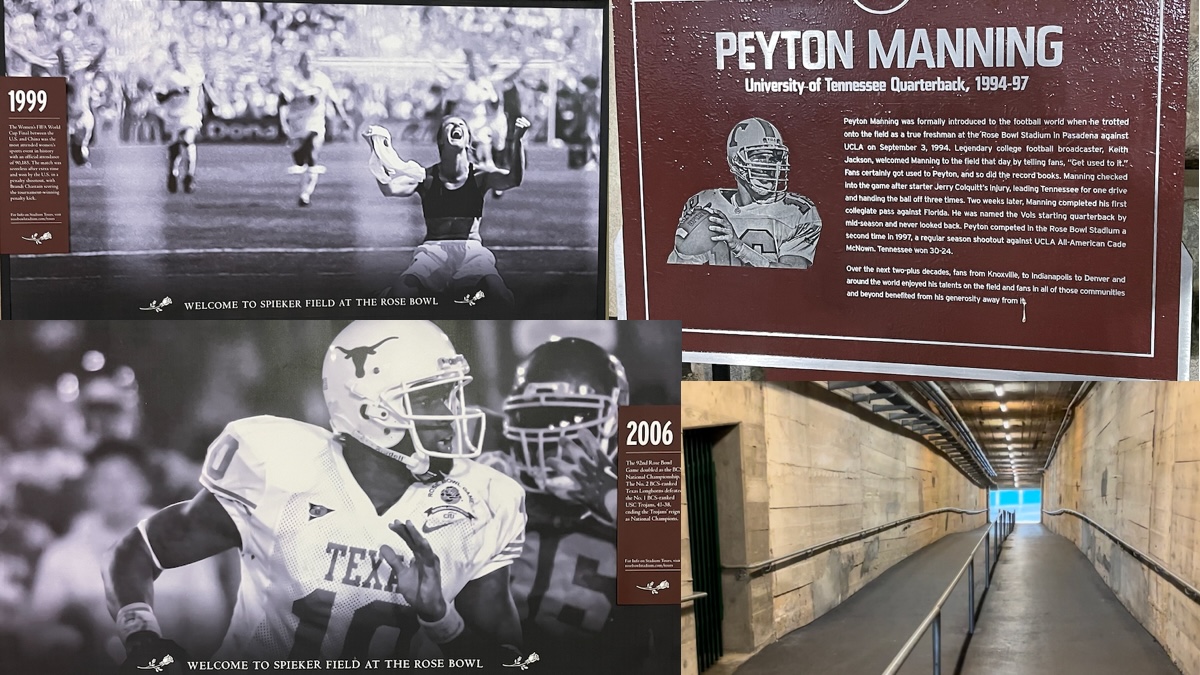
The Legacy Foundation completed a multi-year $40 million centennial fundraising effort in late 2022.
“It’s pretty amazing that you have this group of private individuals that care so much about this publicly owned building to go out and not only give their money, but to ask other people to advocate for us,” Weiden said. “They’re really the reason we’re still here. Because this building wouldn’t be around and relevant if we weren’t investing millions back into it. So we owe Legacy more than probably any group out there.”
The Legacy Foundation is a small, but mighty group. Working under Brozino is Brian Brantley, director of major gifts and advancement; Meredith Thomas, director of communications for the Rose Bowl Stadium & Legacy Foundation and Kelli Gill, development manager. The city of Pasadena — which owns the Rose Bowl — supports those who work for the Rose Bowl Stadium and Legacy Foundation.
The Rose Bowl has done a tremendous job of keeping the stadium updated and with a modern feel, while also giving plenty of nods to its history. There are numerous landmarks located outside the stadium that recall historic moments — the five Super Bowls between 1977 and 1993, the 1999 FIFA Women’s World Cup, the 2006 BCS National Championship Game, Peyton Manning’s first collegiate action, Knute Rockne and Notre Dame playing there in 1925 … the list goes on.
“We have that support from city elected officials that empowers us to really drive things forward through the Foundation and our donors nationwide have felt that support from the city to the point where they’re making their own personal contributions to keep this place alive and enhance it in ways that we’ve never imagined,” Brozino said. “This is a cultural place and I think what makes it special now is that it’s not our grandparents’ Rose Bowl. There is a generation that knows us for the Taylor Swift show, or the Coldplay show, or the flea market. … We still do college football at a very high level, but we’re not just a college football stadium anymore.”
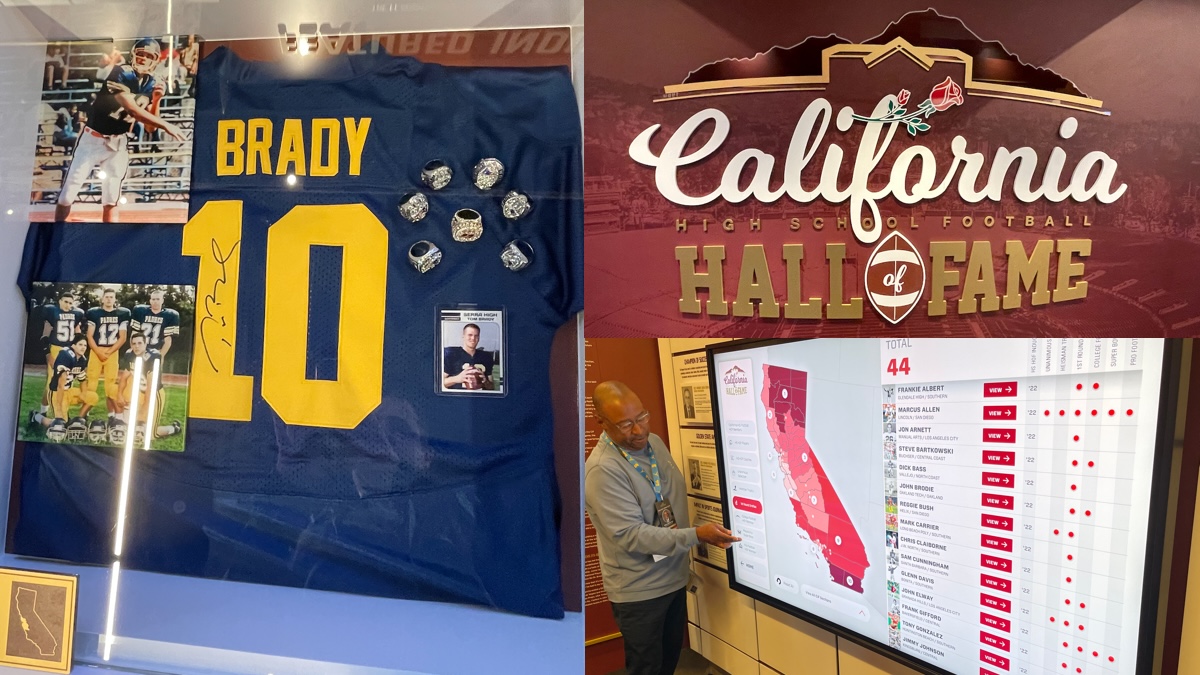
The Legacy Foundation has a board of directors and advisory board that work in conjunction to ensure money coming into the organization is maximized for improving the stadium. My Huynh is a 1994 graduate of UCLA and serves on the advisory board. As an alum, he has seen many historic moments at the Rose Bowl.
“I’m really happy with what Brian and the rest of the Legacy Foundation is doing in terms of basically creating a wraparound approach to maintaining and also expanding the Rose Bowl, because it has to adapt for the 21st century,” Huynh said. “This is not just a football venue, but it’s also a home for huge entertainment.”
As Huynh and his fellow UCLA fans gathered for the last game in Pac-12 history, he couldn’t help but be a bit downcast.
“I’m going to miss the traditional rivalries,” he said. “But I am looking forward to some things, like games out at Columbus or Ann Arbor. But it’s going to be a really tough transition for a lot of the fans. Cal and Stanford not playing every year, that’s really strange as well.”
A Big (Ten) Rebirth
The Pac-12 will cease to exist in 2024 and what happens after next year is anybody’s guess. But that isn’t something that UCLA and the Rose Bowl are worried about.
They’re on to what they perceive to be greener pastures. After the final whistle sounded in Cal’s 33–7 upset win over UCLA, the Bears were officially off to the Atlantic Coast Conference along with Stanford. The Bruins are headed to the Big Ten with rival USC, as well as Oregon and Washington. Arizona, Arizona State, Colorado and Utah are headed to the Big 12.
Throughout the Pac-12’s swan song that night, the videoboards in the Rose Bowl displayed the 2024 home schedule for UCLA, which features Indiana, Oregon, Minnesota, Iowa and USC. It was a strange site for college football traditionalists.
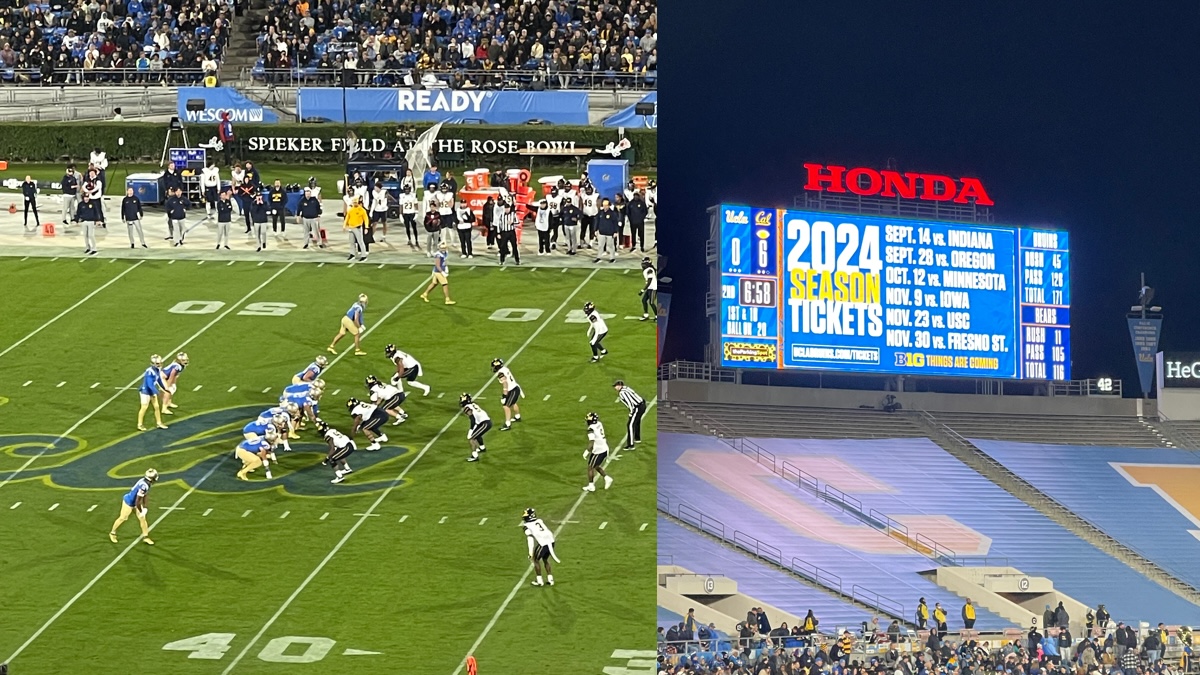
“It’s bittersweet night for us,” Thomas said. “That being said, we are very excited for the move next season to the Big Ten. We’ll have a whole new crop of teams coming in here. The Rose Bowl is 101 years old and moving to a new conference is a chance to continue to share football across the country and to involve teams that have never had the opportunity except for maybe January 1 to play here.”
That is the prevailing sentiment from those on the staffs of the Rose Bowl and Legacy Foundation. The greener pastures of the Big 10 also includes more money coming in the door; Weiden believes the Bruins’ move to the Big Ten is going to be one of the biggest tourism drivers in Los Angeles’ history.
“A school like Minnesota … if they found out they were going to the Rose Bowl game on January 1, the most notice they’d get is three weeks during the holidays,” Weiden said. “Now they’re finding out a year in advance the date in November that they get to come here and they’re going to do Disneyland and Universal, a game at the Rose Bowl or at the (Los Angeles Memorial) Coliseum. That’s sort of the reason the Rose Bowl Stadium was built — for people in Southern California to flex a little bit to show everybody else how great their weather is. And moving conferences continues that tradition.”
Brozino agrees the end of the Pac-12 is bittersweet and it can be tough to adjust when old traditions are changed. But like Weiden, he’s also seeing the financial ramifications.
“If you take a step back and look at it from 10,000 feet, sports have forever evolved, whether it’s through equipment, instant replay technology use or conference alignment,” Brozino said. “We’re going to get fan bases to Pasadena that haven’t been here for decades. Or maybe ever. Next season they play Indiana and it’s the first time Indiana and UCLA have ever played on a college football field.”
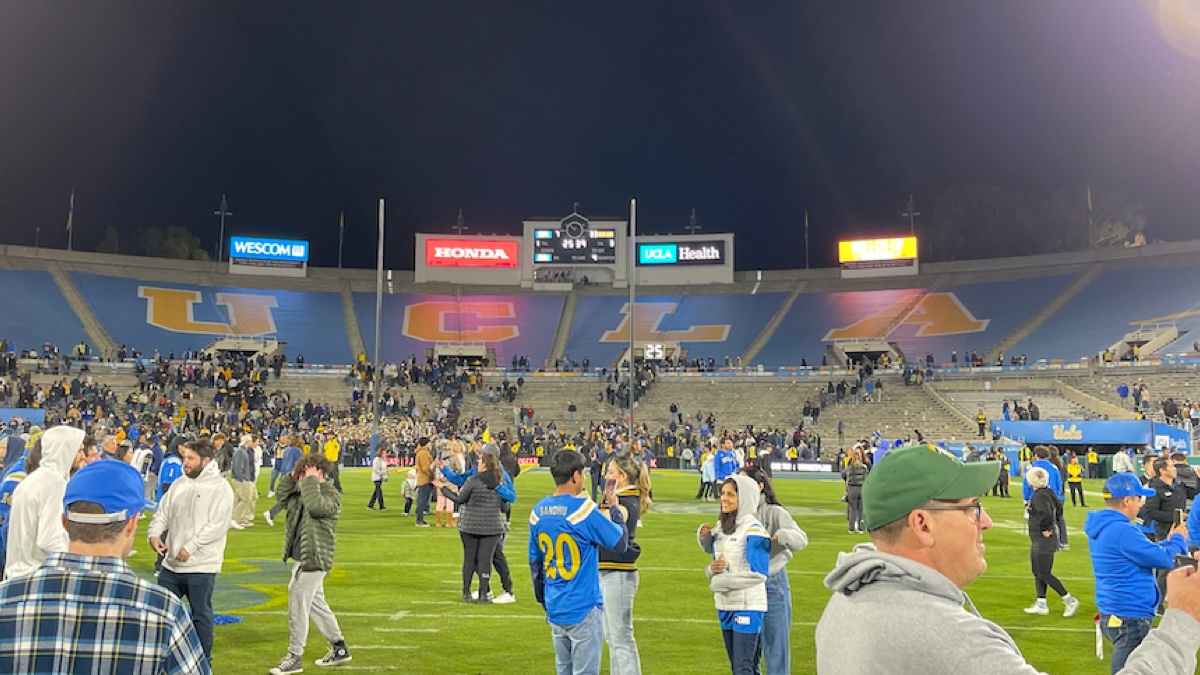
Brozino notes the Rose Bowl is already the top driver of economic impact in Pasadena. The Rose Bowl Game and Rose Parade on New Year’s Day is the top economic impact event in all of Los Angeles County, which is the most populated county in America.
“You couple those things with these fan bases coming to town and not just experiencing Pasadena and our restaurants and the retail, but experiencing Southern California — UCLA and USC going to the Big Ten is one of the biggest things that L.A. has seen in the last 25 years in my opinion,” Brozino said.
As UCLA quarterback Dante Moore’s final pass of the night sailed out of the end zone and time ran out, the Rose Bowl allowed fans onto the field for photos as a thank you for their support not only during the 2023 season, but for the many decades before. Was it appropriate that the Pac-12 as we know it ended in the Rose Bowl?
“I think so,” Huynh said. “The Rose Bowl is always the last stop of the Pac-12 season when you’re playing the Rose Bowl game, traditionally. So I guess it is fitting that this is the right moment for this as well, that they put this as the last Pac-12 game ever.”












 Copyright © 2025 by Northstar Travel Media LLC. All Rights Reserved. 301 Route 17 N, Suite 1150, Rutherford, NJ 07070 USA | Telephone: (201) 902-2000
Copyright © 2025 by Northstar Travel Media LLC. All Rights Reserved. 301 Route 17 N, Suite 1150, Rutherford, NJ 07070 USA | Telephone: (201) 902-2000